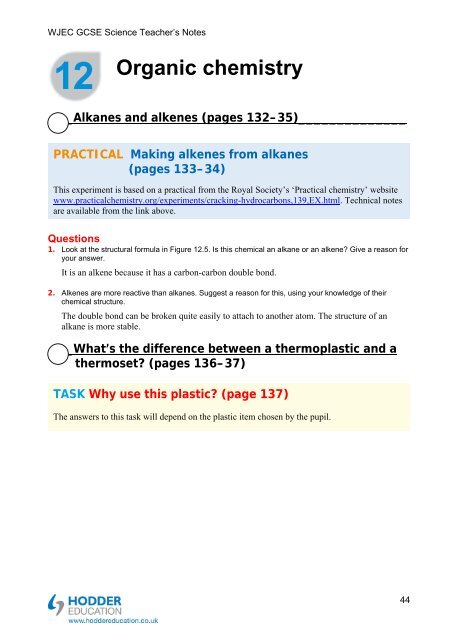Teacher's notes and answers to questions in the book - Hodder Plus ...
Teacher's notes and answers to questions in the book - Hodder Plus ...
Teacher's notes and answers to questions in the book - Hodder Plus ...
Create successful ePaper yourself
Turn your PDF publications into a flip-book with our unique Google optimized e-Paper software.
WJEC GCSE Science Teacher’s Notes<br />
12<br />
Organic chemistry<br />
_Alkanes <strong>and</strong> alkenes (pages 132–35)______________<br />
PRACTICAL Mak<strong>in</strong>g alkenes from alkanes<br />
(pages 133–34)<br />
This experiment is based on a practical from <strong>the</strong> Royal Society’s ‘Practical chemistry’ website<br />
www.practicalchemistry.org/experiments/crack<strong>in</strong>g-hydrocarbons,139,EX.html. Technical <strong>notes</strong><br />
are available from <strong>the</strong> l<strong>in</strong>k above.<br />
Questions<br />
1. Look at <strong>the</strong> structural formula <strong>in</strong> Figure 12.5. Is this chemical an alkane or an alkene Give a reason for<br />
your answer.<br />
It is an alkene because it has a carbon-carbon double bond.<br />
2. Alkenes are more reactive than alkanes. Suggest a reason for this, us<strong>in</strong>g your knowledge of <strong>the</strong>ir<br />
chemical structure.<br />
The double bond can be broken quite easily <strong>to</strong> attach <strong>to</strong> ano<strong>the</strong>r a<strong>to</strong>m. The structure of an<br />
alkane is more stable.<br />
_What’s <strong>the</strong> difference between a <strong>the</strong>rmoplastic <strong>and</strong> a<br />
<strong>the</strong>rmoset (pages 136–37)<br />
TASK Why use this plastic (page 137)<br />
The <strong>answers</strong> <strong>to</strong> this task will depend on <strong>the</strong> plastic item chosen by <strong>the</strong> pupil.<br />
44

















